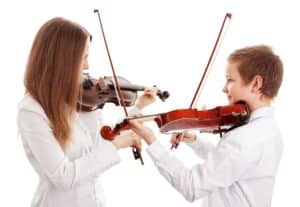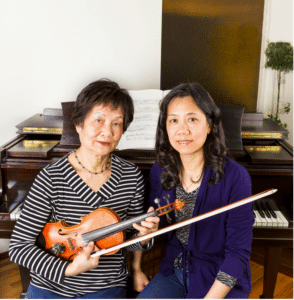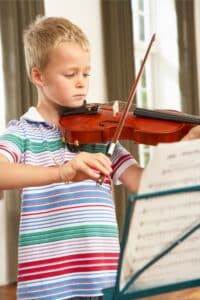Violin Lessons in Sharon

Parents whose kids take violin lessons at the Maestro Musicians Academy's Sharon Music School love the fact that our instructors balance fun music-making with a particular focus on technical growth. Our patient and friendly violin teachers help children, teens, and pre-teens make big accomplishments every week through clear instructions and weekly goals. The result is that students who take our Sharon Violin Lessons look forward to a new musical journey, every week!
Is My Child Ready for Violin Lessons?
We know that young children are often not able to sit or stand still for more than a few minutes at a time, let alone focus for more than a short period. Our instructors are well aware of this and tailor their violin lessons to the student’s individual needs and abilities. Even if your child is very young, our Sharon Violin Teachers have ways to engage and inspire with plenty of age-appropriate activities.
In deciding whether or not to move forward, if you answer yes to the following three questions, we believe that your younger child could be ready:
1. Does my child have the ability to follow instruction when engaged and interested?
2. Can my child maintain a calm body for 5 minutes at a time?
3. Does my child have at least average coordination and muscle tone?
Introducing your child to the world of music can be a rewarding experience that fosters creativity, discipline, and a lifelong appreciation for the arts. The violin, with its rich and enchanting sound, is a popular choice for young aspiring musicians.
However, determining whether your child is ready for violin lessons involves considering various factors.
Age and Physical Development:
While there is no strict age limit for starting violin lessons, physical development is an essential consideration. The violin requires a certain level of fine motor skills, including finger dexterity and hand-eye coordination. Generally, children around the age of 4 or 5 may start to show signs of these skills developing, making it an appropriate time to introduce them to the violin.
Interest and Enthusiasm:
One of the key indicators of readiness is your child's interest in the violin. If they express a genuine curiosity or passion for the instrument, it may be a sign that they are ready to commit to regular practice and lessons. Engaging your child in conversations about music and allowing them to explore various instruments can help you gauge their interest in the violin.
Attention Span and Focus:
Learning to play the violin requires concentration and focus. If your child can sit still and pay attention for short periods, it may be an indication that they are ready for structured lessons. Keep in mind that violin practice demands patience and perseverance, so an ability to stay engaged with an activity for an extended time is beneficial.
Supportive Environment:
Consider the environment at home and whether it is conducive to regular practice. Encouragement from parents, a quiet space for practice, and access to a suitable-sized instrument are crucial factors that contribute to a positive learning experience. A supportive environment ensures that your child feels motivated and comfortable during their musical journey.
Willingness to Learn:
The willingness of your child to embrace the learning process is a vital aspect of readiness. A positive attitude towards challenges, a curiosity to explore new concepts, and an eagerness to learn from mistakes are qualities that will contribute to a successful and enjoyable violin learning experience.
--
Deciding whether your child is ready for violin lessons involves considering a combination of physical, emotional, and environmental factors. By paying attention to their developmental milestones, interests, and overall readiness to learn, you can make an informed decision about introducing your child to the beautiful world of violin music. Remember that every child is unique, and nurturing their individual strengths and interests will contribute to a fulfilling musical journey.

How Long Are Your Sharon Violin Lessons?
Are There Performance Opportunities?
Should I Buy or Rent an Instrument? And Do I Need One Before the First Lesson?
Students are expected to have an instrument for the first lesson. If a student is under the age of 13, we strongly recommend renting the instrument as opposed to buying. The reason for this is because your younger child will go through a few sizes before he or she is ready for a full size instrument. It is generally much easier to rent than to purchase and sell your old instrument. We recommend Johnson String Instrument Company in Newton Upper Falls for rentals. Before you go there, check out their sizing chart so you can save yourself some time!
What Training Do Your Sharon Violin Teachers Have?
What are the Popular Violin Teaching Methods Today?
- Suzuki Method:
Developed by Shinichi Suzuki in the mid-20th century, the Suzuki Method is a widely acclaimed approach that emphasizes learning music in a manner similar to acquiring language skills. In this method, students start playing by ear before learning to read music, fostering a strong foundation in listening and imitation. The Suzuki Method encourages parental involvement, group lessons, and a positive learning environment, creating a holistic approach to violin education.
- Traditional Method:
The traditional method, often associated with Western classical music education, involves a systematic progression of teaching reading musical notation from the beginning. Students using this approach typically start with simple tunes and gradually advance to more complex pieces. Technical exercises, scales, and etudes are essential components, emphasizing a disciplined and structured learning process.
- Galamian Method:
Named after the renowned violin pedagogue Ivan Galamian, this method places a strong emphasis on technical mastery and discipline. The Galamian Method involves a systematic approach to developing skills such as finger strength, bow control, and intonation. It often includes a combination of scales, etudes, and repertoire, with a focus on refining each element to achieve a high level of proficiency.
- Colourstrings Method:
Developed by Hungarian violinist and teacher Géza Szilvay, the Colourstrings Method is an innovative approach designed to introduce music to young children in a playful and engaging way. This method uses a color-coded system to represent different aspects of music, aiding students in understanding and internalizing musical concepts. It places a strong emphasis on ear training, ensemble playing, and creative expression.
- Alexander Technique:
While not a specific violin method, the Alexander Technique is often incorporated into violin teaching to improve overall body awareness, posture, and movement. This technique helps students develop a relaxed and efficient playing posture, reducing tension and preventing injuries. By fostering mindfulness and body awareness, the Alexander Technique contributes to enhanced technical proficiency and musical expression.
Ultimately, the choice of a violin teaching method depends on the individual needs, preferences, and goals of the student. A skilled violin teacher may combine elements from various methods to create a customized approach tailored to the student's learning style. The key is to provide a well-rounded education that not only develops technical skills but also nurtures a love for music, fostering a lifelong appreciation for the art of playing the violin.

Violin Lessons in Sharon!
Our Violin Lessons are Near YOU! The Maestro Musicians Academy's Sharon Music School is located in Sharon Town Center on 9 Washington Place.
Not sure if your child is ready for lessons yet? No problem! We Offer a Trial Period so you have very little to lose.
Schedule Your Free Phone Consultation and We'll Get in Touch Within 1 Business Day!
Click on the button below or get in touch
by calling 339-329-9894,
or e-mailing
lessons@maestromusicians.com!
